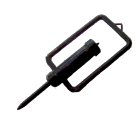The U.S. Army 3D-Printed a Grenade Launcher and Called it R.A.M.B.O.
Of course it's called Rambo.

U.S. Army Acquisition Support Center
By Kyle Mizokami (Popular Mechanics)
In a blend of pop culture showmanship and high tech, the U.S. Army has revealed a grenade launcher made almost entirely from 3D-printed parts. Even better, it fires 3D-printed grenades. The project highlights the Army's interest in integrating new manufacturing technologies, ideally lowering costs and easing supply demands down the road.
Rapid Additively Manufactured Ballistics Ordnance, or R.A.M.B.O., is a modified M203 grenade launcher with a shoulder stock and pistol grip. The M203 grenade launcher is an older, pump-action design that was fitted under the barrel of an M16 rifle or M4 carbine. It's also probably no longer protected by patent.
R.A.M.B.O. consists of 50 individual parts, and all of them with the exception of springs and fasteners were made by 3D printing. The barrel and receiver were made of aluminum using direct metal laser sintering, which the U.S. Army's Acquisition Support Center describes as a " process that uses high-powered precision lasers to heat the particles of powder below their melting point, essentially welding the fine metal powder layer by layer until a finished object is formed". The trigger and firing pin were printed in 4340 steel.

R.A.M.B.O.'s printed parts, minus the receiver and barrel.
U.S. Army Acquisition Support Center
The grenade launcher barrel and receiver took about 70 hours to print and then required 5 hours of post-print finishing. The barrel was tumbled in an abrasive rock bath and then Type III hard-coat anodized to provide a rugged finish.
The Army is impressed with the process, which proves that someone with uncommon 3D printing equipment can actually build durable grenade launcher parts. "The tooling and setup needed to make such intricate parts through conventional methods would take months and tens of thousands of dollars, and would require a machinist who has the esoteric machining expertise to manufacture things like the rifling on the barrel."

3D printed training grenade. Note plastic nose and aluminum sintered body. U.S. Army Acquisition Support Center
The grenade launcher wasn't the only thing the Army 3D printed. Tt made grenades, too. The Army printed several M781 training rounds, which do not have explosives, out of aluminum and glass-filled nylon. The 3D printed grenade launcher and grenades were tested in October 2016 and displayed zero degradation after 15 shots. 3D printed grenades came within five percent of the muzzle velocity of regular production grenades, proving that the system was performing close to the real thing.
Army engineers involved in the project hit just one snag during testing, one that was easily fixed. Early versions of the grenades experienced cracking in the aluminum cases. To fix, engineers simply went into the software and made the walls of the cartridge case thicker. The next grenade was printed with the thicker walls and the problem was solved.
The production of actual, useful heavy weapons has serious implications for defense manufacturing. New designs can be quickly prototyped and tested without creating new, expensive tooling. Down the road, all weapons might someday be produced this way. And even further into the future, it could be possible for soldiers at forward outposts to print their own weapons or critical replacement parts.





